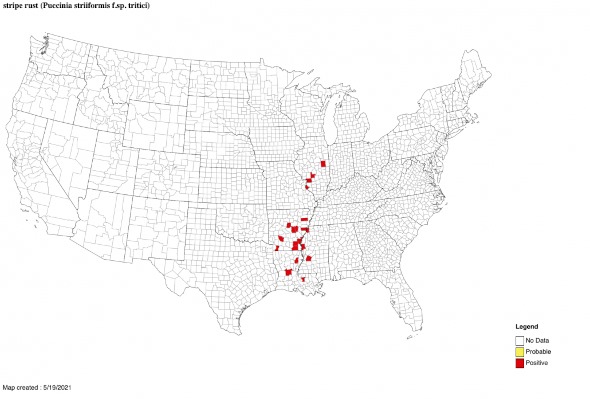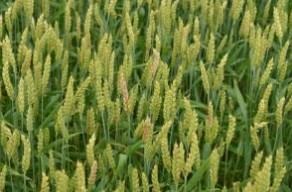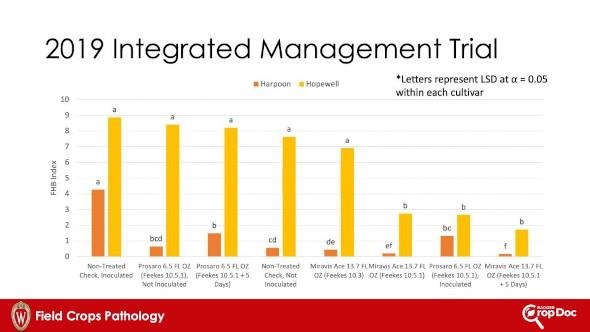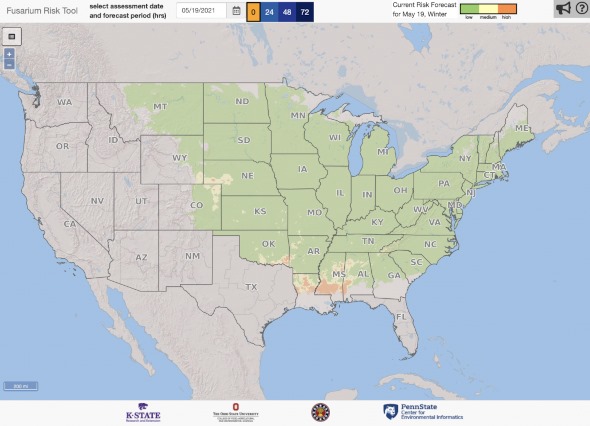By Damon L. Smith
Up until this week, diseases of winter wheat have been basically non-existent. Dry weather leading to a moderate drought in much of the state has meant that the environment has not been favorable for most wheat pathogens of concern for us in the upper Midwest. There is an exception to that rule, and we have observed one disease, and have gotten reports of that disease this week. That disease is powdery mildew and it does tend to follow a few different “rules” when it comes to fungal diseases. Let’s discuss this disease further and then dig in a bit on what you should do for disease management as we move through the rest of the 2021 winter wheat season.
So, what’s up with powdery mildew?

Figure 1. Signs and symptoms associated with powdery mildew on a wheat leaf.
Powdery mildew of winter wheat is caused by the fungus Blumeria graminis f. sp. tritici. The most notable sign of powdery mildew is the white, fluffy fungal growth that occurs on the surface of leaves (Fig. 1). Yellow spots may be present on the underside of the leaf. The white “tufts” might also have very small black pepper-like structures in them. Generally, the disease will start in the lower canopy, and if weather is favorable, will move up the canopy eventually reaching the flag leaf and even infecting heads on susceptible varieties.
The reason that powdery mildew has been an issue this year, despite the dry weather, is that it happens to like cool conditions combined with dew events. Warm days and cool nights often lead to dew and extended periods of leaf wetness (think semi-arid climates). This combined with temperatures less than 80 F, means the fungus can thrive on susceptible varieties. Excessive rain events actually deter this particular fungus, as heavy rain events can wash spores from the leaf. So, it isn’t surprising that we are seeing powdery mildew right now given the weather we have had.
Should you spray fungicide for powdery mildew?
Most of the time I would say no. Often in Wisconsin, the weather begins to turn much warmer as we approach heading and the fungus will stop spreading and remain a novelty in the lower canopy. Remember, once daytime temperatures get above 80 F, the fungus will stop or slow in progression. The key in making the fungicide spray decision is to know the susceptibility of the variety you planted and watch the weather. If the weather remains conducive (temps below 80 F, no rain, but dew) and the variety is ranked susceptible, then spraying around flag leaf emergence might be warranted. You can consult the “Fungicide Efficacy for Control of Wheat Diseases” table for products rated with the best efficacy for powdery mildew. Note that most of the higher rated products are triazole compounds, or compounds with a triazole in their mix. No need to be fancy here, find something that fits your budget and has good efficacy. There should be ample choices.
I don’t care about powdery mildew, but what disease should I keep an eye on next?
The last few seasons, two diseases have been our primary focus on winter wheat in Wisconsin. These diseases are stripe rust and Fusarium head blight (scab or FHB). In 2019 and 2020, only FHB was yield limiting. However, in 2016 and 2017, we dealt with both stripe rust and FHB in the same season. Obviously, this year could be different, but the stripe rust situation is starting to “heat up” a bit to our south. The “Wheat Ag Pest Monitor for Stripe Rust” indicates that there are confirmed cases of stripe rust in central Illinois (Fig. 2). This situation needs to be watched carefully over the next 1-2 weeks in Wisconsin.

Figure 2. Confirmed stripe rust observations in the U.S. as of May 19, 2021.
We are rapidly approaching the first growth stage where the application of fungicide might be warranted if stripe rust is found in your locale or is nearby. Based on recent published research, in years where stripe rust was active at the emerging flag leaf growth stage (Feekes 8), we obtained excellent control of stripe rust and a positive return on investment where we sprayed fungicide at this growth stage with a second application of fungicide for FHB control around anthesis.
Currently there is no stripe rust confirmed in Wisconsin but given the rainy weather recently and the positive confirmations in Illinois, this situation should be closely monitored, and a fungicide might be warranted on susceptible varieties if stripe rust is found prior to heading.
If you decide you need to apply a fungicide, there are many choices with decent efficacy against stripe rust. Again, consult the “Fungicide Efficacy for Control of Wheat Diseases” table for the best ratings for the disease. Find a product that is efficacious and fits your farm budget.
So, what should I do about Fusarium head blight?

Figure 3. Fusarium head blight of winter wheat
Fusarium head blight (Fig. 3) has been a perennial problem for us in Wisconsin over the last 5 years. Not only have we seen significant damage and yield reductions due to the disease, but we have seen significant discounts at the elevator for levels of deoxynivalenol (DON or Vomitoxin) above 2 ppm. It is important to manage this disease actively here in Wisconsin.
Be sure you know the relative susceptibility of the varieties you have planted. We have excellent data showing significant reductions of FHB where we use a resistant variety and then layer a fungicide application on top. In 2019 we evaluated the susceptible variety, Hopewell, against the resistant variety, Harpoon. Figure 4 shows the FHB levels for the two varieties which were also subjected to a fungicide application. Clearly variety resistance works.
When it comes to fungicides for FHB, there are really just three products to choose from. These are Caramba, Prosaro, and Miravis Ace. Again the “Fungicide Efficacy for Control of Wheat Diseases” table shows the efficacy ratings of these products against FHB. Timing is everything when using a fungicide for FHB management. Be sure to time applications at the start of anthesis or within 5-7 days after the start. This is the ideal window of opportunity to control FHB and reduce DON levels in the finished grain. Spraying earlier than anthesis or later than about a week after the start of anthesis will result in lost efficacy, or no control of FHB. Also, these fungicides are effective against stripe rust, so if that disease happens to move in later, a single application of fungicide at the anthesis timing should take care of both problems.

Figure 4. Fusarium head blight index (FHB Index) from a 2019 integrated management trial where the susceptible variety, Hopewell, and the resistant variety, Harpoon, were both treated with various fungicide programs or not treated with fungicide.
There is a disease prediction tool for FHB of wheat. You can find that tool at http://www.wheatscab.psu.edu.This tool should be monitored frequently as your crop approaches anthesis and soon after. It can help you determine if your crop is at risk, based on the weather conditions. While most wheat as of May 19, 2021 is not near heading yet in Wisconsin, you can see in figure 5 that for susceptible FHB varieties, the risk is currently low. Again, dry weather leading up to this week has not been favorable for FHB.

Figure 5. Fusarium head blight risk as of May 19, 2021 in the U.S.
The ‘Take Home’ for wheat management over the next few weeks.
This can be cooked down to two main points. Here they are:
- In some years applying fungicides for stripe rust on susceptible cultivars around Feekes 8 will be needed. Make this decision based on the following:
- The known susceptibility of the variety
- Local presence of strip rust and/or confirmed reports nearby
- Favorable weather (frequent rains and temperatures less than 80 F)
- Plan to apply an FHB fungicide application – especially on susceptible varieties
- Shoot for Anthesis or up to 5-days after the start of anthesis for Prosaro and Caramba fungicides
- Can go slightly earlier (Feekes 10.5; Efficacy slightly reduced compared to typical timing) up to 5-days after the start of anthesis for Miravis Ace
- Watch the “Scab Alerts” – it isn’t perfect, but can help you make a decision (http://www.wheatscab.psu.edu)
Source : wisc.edu